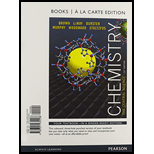
Concept explainers
(a)
To determine:
The properties in the substances that would be important in the application of transferring power.
(a)
Answer to Problem 1DE
Solution:
The important properties are viscosity and volatility of the substances.
Explanation of Solution
The important properties of the three isomers of hexanol are viscosity and volatility.
Hydraulic fluids are used to transfer power in hydraulic machinery such as aircraft flight, controls, excavating equipment and hydraulic brakes. The power is transferred by the fluid which is distributed through hoses and tubes by means of various pumps and valves.
The three isomers of hexanol which are hypothesized to be potentially suitable hydraulic fluids are
Viscosity is an important property. As hydraulic fluid distributes through various pumps and valves, so viscosity is an important property. Another important property is volatility as hydraulic fluid works over a range of temperatures.
The important properties are viscosity and volatility of the substances.
(b)
To determine:
The description of the experiments that determine which of the three alcohols is best suited for use as a hydraulic fluid.
(b)
Answer to Problem 1DE
Solution:
The best suited alcohol is
Explanation of Solution
Viscosity is the resistance of a liquid to flow. To calculate the viscosity of the three alcohols, steel balls experiment will be carried out. Viscosity is determined by measuring the rate at which steel ball fall through the liquid. As the viscosity increases, the steel ball moves slowly.
In
The best suited alcohol is
(c)
To determine:
The hypothesis of the properties that would change from a hexanol to hexanediol and whether experimental procedures be used to explore these properties for hexanediols.
(c)
Answer to Problem 1DE
Solution:
Due to difference in the intermolecular forces of attraction, the properties of hexanol and hexanediols are different. The experimental procedures cannot be used to explore the properties for hexanediols.
Explanation of Solution
The class of compounds called hexanediols is related to hexanols except that they have two
The viscosity of hexanediols will be different from hexanols. Due to presence of two hydroxyl groups, the hydrogen bonding will be more and the intermolecular force of attraction will be higher in hexanediols.
Due to stronger forces of attraction, hexanediols are mostly solid compounds. The above experimental procedure used to determine the viscosity of hexanols cannot be used for hexanediols because hexanediols are organic solids and the metallic balls does not flow through them.
The experimental procedures cannot be used to explore the properties for hexanediols.
Want to see more full solutions like this?
Chapter 11 Solutions
Chemistry: The Central Science, Books a la Carte Edition & Solutions to Red Exercises for Chemistry & Mastering Chemistry with Pearson eText -- Access Card Package
- For the condensation reaction between Alamine and histamine, please help me write the amididation reaction mechanism. Then write the three letter code for the product of the reaction, then write the one letter code for the product of the reaction. arrow_forwardHow to draw the reaction mechasnism belowarrow_forwardName the following molecules with IUpacarrow_forward
- What is the molecular orbital for cyclopropenyl anion and is it aromatic, antiaromatic or nonaromatic?arrow_forwardUsing the chart describe the change from cystine to tyrosine and its impact on the protein. Using the chart describe the change from histidine to aspartic acid and its impact on the protein.arrow_forwardHow to get the predicted product of this reaction belowarrow_forward
- Please help me fill out the chart then using the chart describe the change from cystine to tyrosine and its impact on the protein. Then using the chart describe the change from histidine to aspartic acid.arrow_forwardWrite the Esterification reaction mechanism for acetic acid, and one propanol to make propanol ethanoate (molecule that gives peas its odor in flavor)arrow_forwardProvide solutionsarrow_forward
 ChemistryChemistryISBN:9781305957404Author:Steven S. Zumdahl, Susan A. Zumdahl, Donald J. DeCostePublisher:Cengage Learning
ChemistryChemistryISBN:9781305957404Author:Steven S. Zumdahl, Susan A. Zumdahl, Donald J. DeCostePublisher:Cengage Learning ChemistryChemistryISBN:9781259911156Author:Raymond Chang Dr., Jason Overby ProfessorPublisher:McGraw-Hill Education
ChemistryChemistryISBN:9781259911156Author:Raymond Chang Dr., Jason Overby ProfessorPublisher:McGraw-Hill Education Principles of Instrumental AnalysisChemistryISBN:9781305577213Author:Douglas A. Skoog, F. James Holler, Stanley R. CrouchPublisher:Cengage Learning
Principles of Instrumental AnalysisChemistryISBN:9781305577213Author:Douglas A. Skoog, F. James Holler, Stanley R. CrouchPublisher:Cengage Learning Organic ChemistryChemistryISBN:9780078021558Author:Janice Gorzynski Smith Dr.Publisher:McGraw-Hill Education
Organic ChemistryChemistryISBN:9780078021558Author:Janice Gorzynski Smith Dr.Publisher:McGraw-Hill Education Chemistry: Principles and ReactionsChemistryISBN:9781305079373Author:William L. Masterton, Cecile N. HurleyPublisher:Cengage Learning
Chemistry: Principles and ReactionsChemistryISBN:9781305079373Author:William L. Masterton, Cecile N. HurleyPublisher:Cengage Learning Elementary Principles of Chemical Processes, Bind...ChemistryISBN:9781118431221Author:Richard M. Felder, Ronald W. Rousseau, Lisa G. BullardPublisher:WILEY
Elementary Principles of Chemical Processes, Bind...ChemistryISBN:9781118431221Author:Richard M. Felder, Ronald W. Rousseau, Lisa G. BullardPublisher:WILEY





